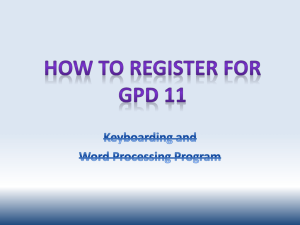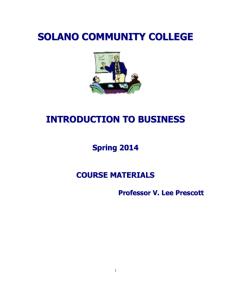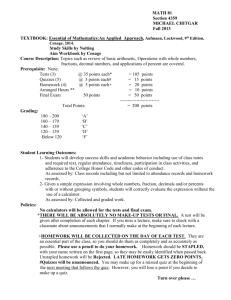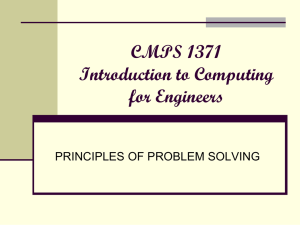BUS181 Fall 14 - Business and Computer Science
advertisement
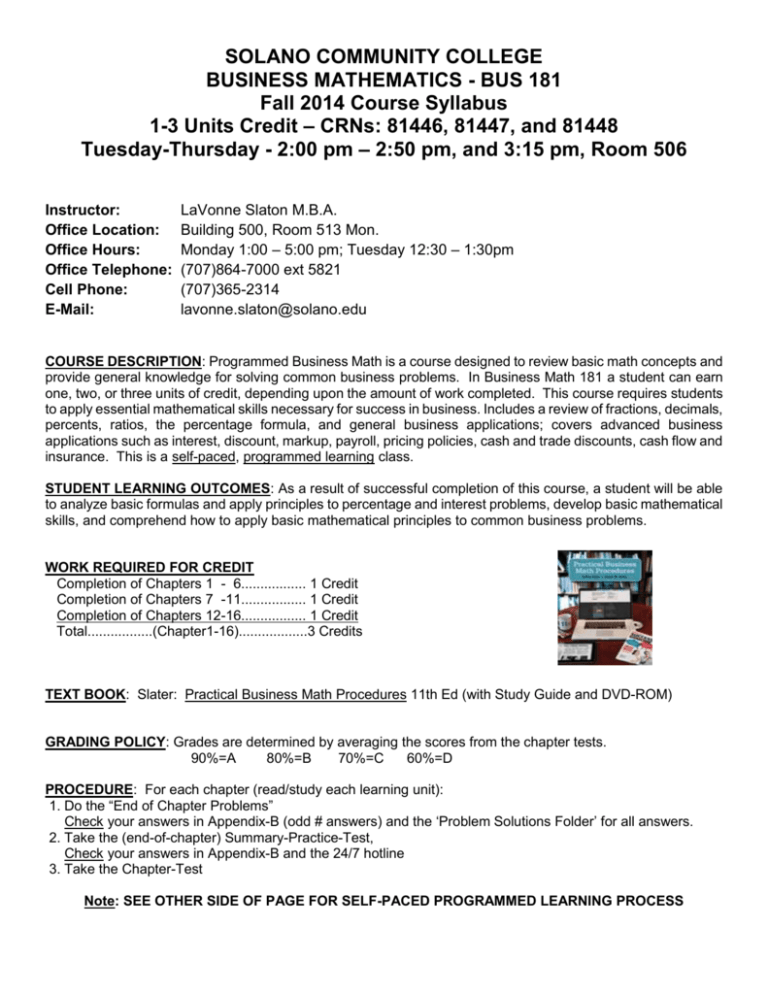
SOLANO COMMUNITY COLLEGE BUSINESS MATHEMATICS - BUS 181 Fall 2014 Course Syllabus 1-3 Units Credit – CRNs: 81446, 81447, and 81448 Tuesday-Thursday - 2:00 pm – 2:50 pm, and 3:15 pm, Room 506 Instructor: Office Location: Office Hours: Office Telephone: Cell Phone: E-Mail: LaVonne Slaton M.B.A. Building 500, Room 513 Mon. Monday 1:00 – 5:00 pm; Tuesday 12:30 – 1:30pm (707)864-7000 ext 5821 (707)365-2314 lavonne.slaton@solano.edu COURSE DESCRIPTION: Programmed Business Math is a course designed to review basic math concepts and provide general knowledge for solving common business problems. In Business Math 181 a student can earn one, two, or three units of credit, depending upon the amount of work completed. This course requires students to apply essential mathematical skills necessary for success in business. Includes a review of fractions, decimals, percents, ratios, the percentage formula, and general business applications; covers advanced business applications such as interest, discount, markup, payroll, pricing policies, cash and trade discounts, cash flow and insurance. This is a self-paced, programmed learning class. STUDENT LEARNING OUTCOMES: As a result of successful completion of this course, a student will be able to analyze basic formulas and apply principles to percentage and interest problems, develop basic mathematical skills, and comprehend how to apply basic mathematical principles to common business problems. WORK REQUIRED FOR CREDIT Completion of Chapters 1 - 6................. 1 Credit Completion of Chapters 7 -11................. 1 Credit Completion of Chapters 12-16................. 1 Credit Total.................(Chapter1-16)..................3 Credits TEXT BOOK: Slater: Practical Business Math Procedures 11th Ed (with Study Guide and DVD-ROM) GRADING POLICY: Grades are determined by averaging the scores from the chapter tests. 90%=A 80%=B 70%=C 60%=D PROCEDURE: For each chapter (read/study each learning unit): 1. Do the “End of Chapter Problems” Check your answers in Appendix-B (odd # answers) and the ‘Problem Solutions Folder’ for all answers. 2. Take the (end-of-chapter) Summary-Practice-Test, Check your answers in Appendix-B and the 24/7 hotline 3. Take the Chapter-Test Note: SEE OTHER SIDE OF PAGE FOR SELF-PACED PROGRAMMED LEARNING PROCESS SELF-PACED PROGRAMMED LEARNING PROCESS: 1 For each Chapter, work through each of the (2-3) ‘Learning Units’ (Do each unit practice quiz) 2 Do the “End of Chapter Problems” (Check answers in Appendix-B and the ‘Solutions Folder’) * Did you make an 85% or better? YES: Proceed to Summary-Practice-Test (Step-3) NO: See “Study Aids” below 3 Take the chapter Summary-Practice-Test, (Check answers in Appendix-B, note 800# support) * Did you make an 85% or better? YES: Proceed to Chapter-Test (Step-4) NO: See “Study Aids” below 4 Take the Chapter-Test. ( proceed to next Chapter) * To calculate your grade divide the number of possible answers into the number that you got correct. METHOD OF INSTRUCTION AND STUDY AIDS: If you scored lower than 85% on the ‘end-of-chapter problems’ or ‘summary-practice-test’ utilize the following study aids (available for each chapter). A. STUDENT DVD-ROM: ‘Student DVD-ROM’ that contains: Tutorials, Practice Quizzes, Practice Quiz video reviews, PowerPoint lecture files, and Web Links for additional help. B. TEXT WEB SITE: www.nhhe.com/slater11e Contains the DVD-ROM information (sans videos) C. HAND BOOK & STUDY GUIDE: Contains: Reference Sheets & Study Guide D. ADDITIONAL HOMEWORK ASSIGNMENTS Appendix-A has a complete set of drills and word problems arranged by learning unit E. USE OF CALCULATORS Calculators are allowed (and encouraged) to be used in the course. Note, however, that some answers may be required to be given in fractional terms – especially Chapter 2 (Fractions). Last Day to Add / Drop Number of Credits: CRN 81446 Tuesday, November 18, 2014 CRN 81447 Thursday, November 13, 2014 CRN 81448 Thursday, November 13, 2014 Final Exam: Thursday, December 11, 2014 at 1:30 - 3:30pm Student Responsibilities Attendance and Participation Students must attend the first meeting of their classes to assure verification of their enrollments. Students failing to appear may be dropped from class rolls. Regular attendance and participation is required of all students enrolled in courses and laboratories at Solano College. This includes regular attendance, completion of examinations, assignments, participation in class activities and discussions. Instructors shall provide students with written statements describing course requirements, grading standards and course prerequisites. Regular attendance is an obligation assumed by every student at the time of registration. Absences per semester should not exceed the number of hours or the number of days that a class meets per week. Absences in excess of the maximum may result in students being dropped from classes or having their grades lowered. Students who fail to attend their classes may be dropped by their instructors no later than the end of 62.5% of a full-term class, short-term class, or summer session. Students have the responsibility for verifying their enrollment status. Students who withdraw from classes are responsible for initiating the drop process by the appropriate deadlines. It is the responsibility of students to know the status of their attendance records and to complete all academic work missed due to absences. Compliance with the above regulations may be waived in the presence of verifiable extenuating circumstances including accidents, illnesses, shift changes and temporary changes in military assignments. Students who are dropped from classes because of unsatisfactory attendance and/or participation may petition their instructors for class reinstatement. Instructors may reinstate a student by signing an add card and writing "Reinstate" on the card. The add card must be submitted to the Office of Admissions and Records. Withdrawal from Class Students are responsible for officially withdrawing from classes. To officially withdraw from a class, students must: 1. Drop the course(s) using online services at www.solano.edu 2. Turn in a completed drop card at the Office of Admissions and Records (Building 100). Refunds are not automatic. If you are entitled to a refund, you must submit a completed “Refund Request” form (available from the Office of Admissions and Records, Building 100). Refer to the current Schedule of Classes for applicable time frames and policies regarding refunds. A student may withdraw from a class during the first four weeks of instruction. Courses dropped by the end of the first four weeks of instruction will not appear on the student's record. Courses dropped after 30% of instruction through the end of 62.5% (full term classes only) of instruction will be recorded as a "W" on the student's record. A student must petition the Academic Council for a "W" after the last day to drop if extenuating circumstances apply. Documentation is required. Short-term or summer session courses, which are less than a full semester in length, dropped during the first 30% of the class will not appear on the student's record. Courses dropped 31% to 62.5% of the term/session will be recorded as a "W" on the student's record. Courses dropped after 62.5% of the term/session may be recorded as a "W" if extenuating circumstances apply. Failure to appropriately drop a class may result in a grade of "F" for the course. The student must petition the Academic Council and provide documentation to verify cases of accidents, illnesses, or other circumstances beyond the control of the student. Withdrawal from College Students who find it necessary to drop all courses during the semester are required to fill out a Withdrawal Card at the Office of Admissions and Records. Seeing a counselor is advised before deciding to withdraw. It is important to clear any debts owed to the College before leaving the College. Failure to withdraw properly could result in a failing grade. Academic Honesty Policy The College community functions best when its members treat one another with honesty, fairness, respect and trust. Therefore, an individual should realize that deception for the purpose of individual gain is an offense against the members of the College community. Violation of the Academic Honesty Policy includes but is not limited to: 1. Plagiarism – from the Latin word for “kidnap” – involves using another’s work without giving proper credit, whether done accidentally or on purpose. This includes not only words and ideas, but also graphs, artwork, music, maps, statistics, diagrams, scientific data, software, films, videos and the like. Plagiarism is plagiarism whether the material is from published or unpublished sources. It does not matter whether ideas are stolen, bought, downloaded from the Internet, or written for the student by someone else – it is still plagiarism. Even if only bits and pieces of other sources are used, or outside sources reworded, they must still be cited. To avoid problems, students should cite any source(s) and check with the instructor before submitting an assignment or project. Students are always responsible for any plagiarism in their work. An instructor who determines that a student has cheated or plagiarized has the right to give a failing (i.e. “F”) grade, or numerical equivalent, for the assignment or examination. 2. Violation of class assignments, examination rules, e.g., communicating or transferring information to another student, using any materials such as books, notes, etc., other than those expressly allowed for the exam, looking at another student’s exam, etc. 3. Unauthorized preparation, giving, selling, transfer, distribution, or publication, for any commercial purpose, of any contemporaneous recording of an academic presentation in a classroom or equivalent site of instruction, including, but not limited to, handwritten or computer generated class notes, except as permitted by any college policy or administrative procedure. Accommodations If a student has a condition such as a physical or learning disability, which will make it difficult to carry out the work or will require accommodations, please notify me as soon as possible. The student will also need to contact the Disability Services Program (DSP) office located in building 400 or phone (707)864-7136. All information and documentation is confidential. Please feel encouraged to make an appointment with me to discuss specific learning needs in this class. Welcome to BUS 181 This syllabus and the information attached provides essential information about this course. Please plan to refer to it often as questions arise. The tentative schedule attached is an approximate schedule and may be altered as needed for particular topics or unforeseen circumstances. Good luck and enjoy the class! Professor Slaton SCC Institutional Learning Outcomes (ILOs) Upon completion of Solano Community College’s General Education program, a student will demonstrate competency in the following areas: I. Communication Students will communicate effectively, which means the ability to: A. Read – Students will be able to comprehend and interpret: various types of written information in (1) expository prose and imaginative literature (including essays, short fiction and novels), (2) documentation such as manuals, reports, and graphs. B. Write – Students demonstrate the ability to: • Communicate thoughts, ideas, information, and messages in writing • Compose and create documents such as manuals and graphs as well as formal academic essays, observing rules of grammar, punctuation and spelling, and using the language, style, and format appropriate to academic and professional settings • Check, edit, and revise written work for correct information, appropriate emphasis, form, style, and grammar C. Listen – Students will be able to receive, attend to, interpret, and respond appropriately to (1) verbal, and/or (2) nonverbal messages D. Speak and Converse – Students have the ability to: • Organize ideas and communicate verbal or nonverbal messages appropriate to the audience and the situation • Participate in conversations, discussions, and group activities • Speak clearly and ask appropriate questions II. Critical Thinking and Information Competency Thinking critically is characterized by the ability to perform: A. Analysis – demonstrated by the ability to: • Apply appropriate rules and principles to new situations • Discover rules and apply them in the problem solving process • Draw logical conclusions based on close observation and analysis of information • Differentiate among facts, influences, opinions, assumptions, and conclusions B. Computation – demonstrated by the ability to: • Use basic numerical concepts • Use tables, graphs, charts, and diagrams to explain concepts • Use basic geometrical shapes C. Research – demonstrated by the ability to: • State a research question, problem, or issue • Use discipline appropriate information tools to locate and retrieve relevant information efficiently • Analyze and evaluate information for appropriateness, relevance, and accuracy • Synthesize, evaluate, and communicate information using a variety of information technologies • Recognize the ethical and legal issues surrounding information and information technologies • Demonstrate understanding of academic integrity and honesty D. Problem Solving –demonstrated by the ability to: • Recognize whether a problem exists • Identify components of the problem or issue • Create a plan of action to respond to and/or resolve the issue appropriately • Monitor, evaluate, and revise as necessary III. Global Awareness Students will demonstrate a measurable understanding and appreciation of the world including its: A. Scientific Complexities – Students demonstrate an understanding of: • The scientific method and its application in experiments • How experiments work • The major differences between social, natural and physical sciences B. Social Diversity and Civics – Students demonstrate ability to: • Communicate with people from a variety of backgrounds • Understand different cultural beliefs and behaviors • Recognize important social and political issues in their own community C. Artistic Variety – Students have been exposed to: • The visual and performing arts of one or more cultures • Analytical techniques for understanding the meaning in the arts, and/or • Hands-on experience with creative endeavors IV. Personal Responsibility & Professional Development A. Self-Management and Self-Awareness –The student is able to: • Accurately assess his/her own knowledge, skills, and abilities • Motivate self and set realistic short and long-term goals • Accept that assessment is important to success • Respond appropriately to challenging situations B. Social and Physical Wellness – Students make an appropriate effort to: • Manage personal health and well being • Demonstrate appropriate social skills in group settings C. Workplace Skills – Students understand how to: • Be dependable, reliable, and accountable • Meet deadlines and complete tasks
